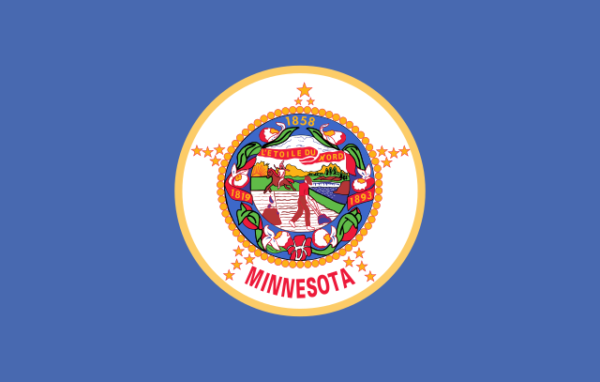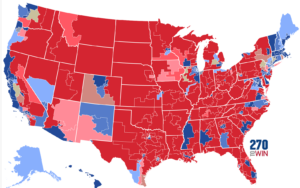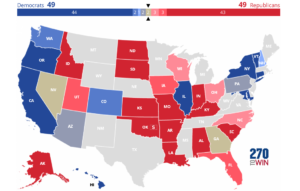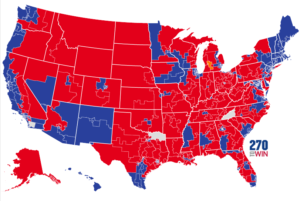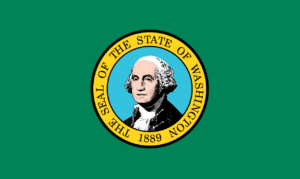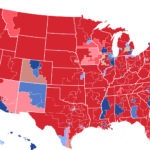As we prepare for the 2020 elections, Yesh Ginsburg and Steen Kirby will give a general overview of all 435 United States House of Representatives races. This is a basic overview to introduce you to the major candidates. All Partisan Lean numbers are taken from the Cook Partisan Voting Index. We will update this page as the races progress if anything noteworthy arises.
Minnesota has eight Congressional Districts. The delegation is currently controlled by Democrats, who have five of the seats. However, this is a pretty even state in terms of Congress, and we could see some very tight races in November. Let’s take a look at all the candidates.
Minnesota’s 1st Congressional District
Incumbent: Jim Hagedorn (Republican, first term)
Partisan Lean: R+5
2018 Results:
| Candidate | Votes | % |
| Jim Hagedorn (R) | 146,202 | 50.13 |
| Dan Feehan (D) | 144,891 | 49.68 |
2016 Results:
| Candidate | Votes | % |
| Tim Walz (D) | 169,074 | 50.34 |
| Jim Hagedorn (R) | 166,526 | 49.58 |
Republican Candidate:
Jim Hagedorn (campaign website)
Hagedorn is a somewhat-moderate Republican who is focusing on local rural farming issues, as well as small job creation and a somewhat free market solution to healthcare costs, while still protecting pre-existing conditions.
Democratic Candidate:
Dan Faheen (campaign website)
Faheen almost held this seat two years ago, and he’s back to try again. He is generally moderate and focuses mostly on issues that directly affect local rural voters, but he also advocates for fighting climate change.
Minnesota’s 2nd Congressional District
Incumbent: Angie Craig (Democratic, first term)
Partisan Lean: R+2
2018 Results:
| Candidate | Votes | % |
| Angie Craig (D) | 177,958 | 52.66 |
| Jason Lewis (R) | 159,344 | 47.15 |
2016 Results:
| Candidate | Votes | % |
| Jason Lewis (R) | 173,970 | 46.95 |
| Angie Craig (D) | 167,315 | 45.16 |
| Paula Overby (Independence Party) | 28,869 | 7.79 |
Republican Candidate:
Tyler Kistner (campaign website)
Kistner is a small government Republican focusing on lowering taxes and business regulations, while expanding the military to worry about global threats. He both wants to decrease government spending to cut the deficit, while at the same time advocates for $3 trillion in federal infrastructure spending. Kistner has raised a large amount of money and is spending, though Craig is far better-funded.
Democratic Candidate:
Angie Craig (campaign website)
Craig flipped this seat two years ago and is looking to hold it. She is a very moderate Democrat, who supported President Trump’s USMCA and looks for bipartisan solutions to climate change. She also wants to increase government grants for college students and other educational opportunities.
Minnesota’s 3rd Congressional District
Incumbent: Dean Phillips (Democratic, first term)
Partisan Lean: D+1
2018 Results:
| Candidate | Votes | % |
| Dean Phillips (D) | 202,404 | 55.61 |
| Erik Paulsen (R) | 160,839 | 44.19 |
2016 Results:
| Candidate | Votes | % |
| Erik Paulsen (R) | 223,077 | 56.7 |
| Terri Bonoff (D) | 169,243 | 43.01 |
Republican Candidate:
Kendall Qualls (campaign website)
Qualls has raised a lot of money and is spending to try to flip this district back. He is not campaigning on particular policies, but mostly focuses on general bipartisan and unifying ideals. Qualls has not been overly focusing on support for President Trump, which makes sense in this district.
Democratic Candidate:
Dean Phillips (campaign website)
The margin that Phillips won by two years ago shows just how quickly and powerfully this district moved away from President Trump and the Republicans. He wants to lower business regulations, create a public option for healthcare, and raise taxes on the wealthy.
Minnesota’s 4th Congressional District
Incumbent: Betty McCollum (Democratic, tenth term)
Partisan Lean: D+14
2018 Results:
| Candidate | Votes | % |
| Betty McCollum (D) | 216,865 | 65.99 |
| Greg Ryan (R) | 97,747 | 29.75 |
| Susan Pendergast Sindt (Legal Marijuana) | 13,776 | 4.19 |
2016 Results:
| Candidate | Votes | % |
| Betty McCollum (D) | 203,299 | 57.76 |
| Greg Ryan (R) | 121,032 | 34.39 |
| Susan Pendergast Sindt (Legal Marijuana) | 27,152 | 7.71 |
Republican Candidate:
Gene Rechtzigel (campaign website)
Rechtzigel won his primary over the far better-funded Sia Lo, and he is certainly a unique candidate. I really don’t know how to present him in an objective way, so I’d recommend just looking at his site for yourself. The only thing he seems consistent on in his desire to repeal the 17th Amendment.
Democratic Candidate:
Betty McCollum (campaign website)
McCollum is a consistent liberal Democrat, who runs on her voting record of aligning with the Democratic Party.
Minnesota‘s 5th Congressional District
Incumbent: Ilhan Omar (Democratic, first term)
Partisan Lean: D+26
2018 Results:
| Candidate | Votes | % |
| Ilhan Omar (D) | 267,703 | 77.97 |
| Jennifer Zielinski (R) | 74,440 | 21.68 |
2016 Results:
| Candidate | Votes | % |
| Keith Ellison (D) | 259,964 | 69.07 |
| Frank Drake (R) | 80,660 | 22.29 |
| Dennis Schuller (Legal Marijuana) | 30,759 | 8.5 |
Republican Candidate:
Lacy Johnson (campaign website)
Johnson is seriously well-funded. In fact, he has almost as much money for this race as Omar does, a shocking fact for a district this blue. He is a very moderate Republican, though he is pushing back against left-wing activism regarding police departments. A Black Republican, he supports Opportunity Zones and other issues affecting the Black community. He also supports free market solutions to lower healthcare costs.
Democratic Candidate:
Ilhan Omar (campaign website)
Omar is a progressive Democrat, supporting Medicare for All, the Green New Deal, and other progressive policies. She fended off a very well-funded primary challenge from another candidate that supported progressive policies with relative ease, so it’s hard to see a well-funded Republican making much of an impact.
Minnesota’s 6th Congressional District
Incumbent: Tom Emmer (Republican, third term)
Partisan Lean:
2018 Results:
| Candidate | Votes | % |
| Tom Emmer (R) | 192,931 | 61.11 |
| Ian Todd (D) | 122,332 | 38.75 |
2016 Results:
| Candidate | Votes | % |
| Tom Emmer (R) | 235,380 | 65.58 |
| Savid Snyder (D) | 123,008 | 34.27 |
Republican Candidate:
Tom Emmer (campaign website)
Elmer is the chair of the NRCC. He campaigns on his record, including infrastructure, education, and suicide prevention. He also wants to lower healthcare costs while protecting those with pre-existing conditions.
Democratic Candidate:
Tawnja Zahradka (campaign website)
Zahradka’s website is a list of interesting and seemingly unconnected ideals. She is generally presenting liberal platitudes, and she also calls herself a fiscal conservative.
Minnesota’s 7th Congressional District
Incumbent: Collin Peterson (Democratic, 15th term)
Partisan Lean: R+12
2018 Results:
| Candidate | Votes | % |
| Collin Peterson (D) | 146,672 | 52.1 |
| Dave Hughes (R) | 134,668 | 47.84 |
2016 Results:
| Candidate | Votes | % |
| Collin Peterson (D) | 173,589 | 52.47 |
| Dave Hughes (R) | 156,952 | 47.44 |
Republican Candidate:
Michelle Fischbach (campaign website)
Fischbach is well-funded to try to flip this district. She is running on responding to the needs of rural Minnesotans, as well as a standard Republican platform on guns, immigration, and healthcare.
Democratic Candidate:
Collin Peterson (campaign website)
Peterson is one of the most extreme examples of a cross-party representative. He has held on to this seat against consistent Republican opposition. The right-leaning district likes him because he has represented rural Minnesota well for decades, including agriculture and infrastructure funding.
Minnesota’s 8th Congressional District
Incumbent: Pete Stauber (Republican, first term)
Partisan Lean: R+4
2018 Results:
| Candidate | Votes | % |
| Pete Stauber (R) | 159,364 | 50.72 |
| Joe Radinovich (D) | 141,950 | 45.18 |
| Ray Skip Sandman (Independence) | 12,741 | 4.05 |
2016 Results:
| Candidate | Votes | % |
| Rick Nolan (D) | 179,098 | 50.17 |
| Stewart Mills (R) | 177,089 | 49.61 |
Republican Candidate:
Pete Stauber (campaign website)
Stauber runs on his record as a Congressman and his accomplishments for the district. A former professional hockey player, Stauber is liked and funded well enough to get through on name recognition and popularity even without major concrete policy proposals.
Democratic Candidate:
Quinn Nystrom (campaign website)
Nystrom is a moderate Democrat, running on local issues like lowering property taxes and expanding high speed internet to rural Minnesota. She is also campaigning on working to lower healthcare costs. She is well-funded in this race and will make a challenge of it, though Stauber has a considerably larger war chest.
Overview
Minnesota will be one of the most-watched states in November. The 1st, 2nd, and 7th Districts are all expected to be battlegrounds, and it would not at all be surprising if the 8th was as well, and maybe even the 3rd.
Interested in the rest of our primers for other House races? We have them all listed on our primer home page.

